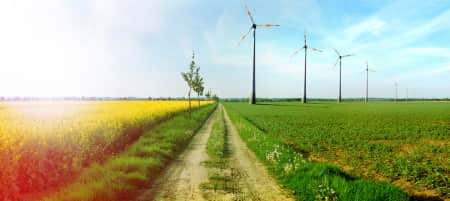Renewable energy is changing the job market, the energy sector, government policies and even corporate investments. But how is the rise of renewable energy changing the construction industry?
What Is Renewable Energy?
Renewable energy is also called clean energy. It refers to natural power that we generate from sources that are constantly replenished. To gain access to this energy, we don’t need to remove anything from the ground or take away or use up any naturally occurring sources.
Examples of renewable energy include solar energy, wind energy and hydroelectric power. Solar panels are found in “farms”, wind energy comes from “parks” and hydroelectricity comes from dams or generators.
Why Renewable?
The shift towards renewable energy is driven by the push for a sustainable future. In 2020, 12% of the energy consumed in the United States came from renewable sources. The goal currently for the USA is to have renewables account for 42% of energy generated by 2050.
Traditional energy sources include fossil fuels, natural gas, oil, coal, and other mined sources. Nuclear energy is non-renewable energy but is considered to be zero-emissions, making it greener than other traditional sources.
This transition is huge. There are a lot of coming changes for the construction industry in regards to sustainable energy and it has already caused some major shifts.
Here are some of the ways that the rise of renewable energy is changing construction.
Increase in Green-Industry Construction Projects
As wind, solar, hydro and nuclear power become more popular there is an increase in green-focused construction projects as a whole.
One of the biggest challenges with green energy is having the ability to transport and store it. Power facilities, power lines, connections between energy parks and cities and other supporting facilities are needed. As the world shifts its focus to renewables, the demand for supporting infrastructure will grow.
If you’re a general construction company, now is the time to learn what you can about these projects. The demand will be coming in waves and the sooner you’re prepared to bid on them, the better.
Diversification of Construction Roles
Construction used to be about roads, commercial buildings, infrastructure and residential jobs. Infrastructure used to be all about schools, hospitals and large community buildings. Over the past decade, there has been a growing demand for construction workers who know how to build hydroelectric dams, solar farms or wind turbines. This is a whole new sector of construction that didn’t exist 20 years ago.
Construction is evolving as fast as the power industry is and the demand is there.
The great news? New opportunities that could catch the attention of new and experienced workers alike. It could help draw the next generation into the industry in a way that simply wouldn’t be possible before. Green and construction aren’t often put together and this may be a deterrent for some to join the industry in the first place. These shifts in construction jobs can change that.
Unfortunately, this appeal could have a downside: It could pull labor away from an already lacking workforce for general construction.
Growing focus on Green Construction Practices
The growing focus on renewables goes hand in hand with other green changes. In construction, we see this all the time. There’s an increased interest in LEED Certification for buildings, on renewable materials and sustainable building practices. Green roofs, net-zero emission buildings and wooden structures are just three of many growing green building trends. Plus, solar panels or wind turbines have been seen as additions to malls, large buildings and commercial projects.
Even if you aren’t directly working in the renewable energy sector, green construction is still there. Expect to see it more and more.
Changes to Equipment
The push towards renewable and sustainable energy has caused many changes to take place for construction equipment.
One of the most obvious changes is the introduction of electric equipment. This change has happened at different rates for different industries. Landscaping, for example, has seen the changeover to electric machines and tools much earlier than the rest of the industry.
With batteries becoming more efficient and powerful, we’re finally seeing mainstream equipment suppliers like CAT and Volvo introduce electronic machines into their fleets.
Along with fully electric equipment, the focus on green energy and reduced emissions has pushed the industry towards more energy-efficient machines. Changes in engines, hybrid models and the addition of technology to monitor fuel consumption are all helping to make equipment greener.
With these new technologies being readily available, there’s no doubt that it will become a selling point when bidding on jobs for the future. If a wind park or solar farm is looking for a construction company, there’s no doubt that a company using battery-operated, electric or energy-efficient machines would stand out against the competition.
Renewable Energy in Construction
You may not think that the rise of renewable energy is impacting construction but it is. Goals and projections around renewables all focus on the same thing: Growth. Pay attention to these trends and be prepared for how they will effect the industry.

